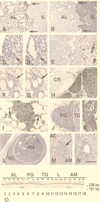RB-mediated suppression of spontaneous multiple neuroendocrine neoplasia and lung metastases in Rb+/- mice
- PMID: 10097138
- PMCID: PMC22395
- DOI: 10.1073/pnas.96.7.3916
RB-mediated suppression of spontaneous multiple neuroendocrine neoplasia and lung metastases in Rb+/- mice
Abstract
Alterations in pathways mediated by retinoblastoma susceptibility gene (RB) product are among the most common in human cancer. Mice with a single copy of the Rb gene are shown to develop a syndrome of multiple neuroendocrine neoplasia. The earliest Rb-deficient atypical cells were identified in the intermediate and anterior lobes of the pituitary, the thyroid and parathyroid glands, and the adrenal medulla within the first 3 months of postnatal development. These cells form gross tumors with various degrees of malignancy by postnatal day 350. By age of 380 days, 84% of Rb+/- mice exhibited lung metastases from C-cell thyroid carcinomas. Expression of a human RB transgene in the Rb+/- mice suppressed carcinogenesis in all tissues studied. Of particular clinical relevance, the frequency of lung metastases also was reduced to 12% in Rb+/- mice by repeated i.v. administration of lipid-entrapped, polycation-condensed RB complementary DNA. Thus, in spite of long latency periods during which secondary alterations can accumulate, the initial loss of Rb function remains essential for tumor progression in multiple types of neuroendocrine cells. Restoration of RB function in humans may prove an effective general approach to the treatment of RB-deficient disseminated tumors.
Figures




Similar articles
-
Suppression of melanotroph carcinogenesis leads to accelerated progression of pituitary anterior lobe tumors and medullary thyroid carcinomas in Rb+/- mice.Cancer Res. 2005 Feb 1;65(3):787-96. Cancer Res. 2005. PMID: 15705875
-
Tumor formation in mice with somatic inactivation of the retinoblastoma gene in interphotoreceptor retinol binding protein-expressing cells.Oncogene. 2002 Jul 11;21(30):4635-45. doi: 10.1038/sj.onc.1205575. Oncogene. 2002. PMID: 12096340
-
Mechanism of retinoblastoma gene inactivation in the spectrum of neuroendocrine lung tumors.Am J Respir Cell Mol Biol. 1998 Feb;18(2):188-96. doi: 10.1165/ajrcmb.18.2.3008. Am J Respir Cell Mol Biol. 1998. PMID: 9476905
-
Murine models of neoplasia: functional analysis of the tumour suppressor genes Rb-1 and p53.Cancer Metastasis Rev. 1995 Jun;14(2):125-48. doi: 10.1007/BF00665796. Cancer Metastasis Rev. 1995. PMID: 7554030 Review.
-
Small cell lung cancer: significance of RB alterations and TTF-1 expression in its carcinogenesis, phenotype, and biology.Endocr Pathol. 2009 Summer;20(2):101-7. doi: 10.1007/s12022-009-9072-4. Endocr Pathol. 2009. PMID: 19390995 Review.
Cited by
-
Wide spectrum of tumors in knock-in mice carrying a Cdk4 protein insensitive to INK4 inhibitors.EMBO J. 2001 Dec 3;20(23):6637-47. doi: 10.1093/emboj/20.23.6637. EMBO J. 2001. PMID: 11726500 Free PMC article.
-
Delivery systems for pulmonary gene therapy.Am J Respir Med. 2002;1(1):35-46. doi: 10.1007/BF03257161. Am J Respir Med. 2002. PMID: 14720074 Free PMC article. Review.
-
Targeted delivery of nucleic-acid-based therapeutics to the pulmonary circulation.AAPS J. 2009 Mar;11(1):23-30. doi: 10.1208/s12248-008-9073-0. Epub 2009 Jan 9. AAPS J. 2009. PMID: 19132538 Free PMC article. Review.
-
Pancreatic Neuroendocrine Tumors: Molecular Mechanisms and Therapeutic Targets.Cancers (Basel). 2021 Oct 12;13(20):5117. doi: 10.3390/cancers13205117. Cancers (Basel). 2021. PMID: 34680266 Free PMC article. Review.
-
Genetic analysis of the cooperative tumorigenic effects of targeted deletions of tumor suppressors Rb1, Trp53, Men1, and Pten in neuroendocrine tumors in mice.Oncotarget. 2020 Jul 14;11(28):2718-2739. doi: 10.18632/oncotarget.27660. eCollection 2020 Jul 14. Oncotarget. 2020. PMID: 32733644 Free PMC article.
References
Publication types
MeSH terms
Substances
Grants and funding
LinkOut - more resources
Full Text Sources
Other Literature Sources
Medical
Molecular Biology Databases

